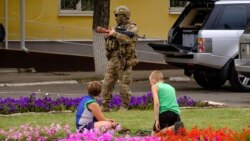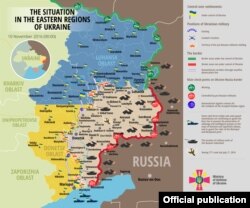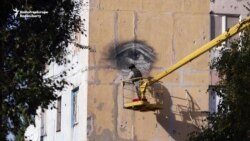We are now closing the live blog for today, but we'll be back with all the latest developments tomorrow morning. Until then, you can catch up with all our other Ukraine coverage here.
Here is today's map of the situation in the Donbas conflict zone, according to the Ukrainian Defense Ministry:
Here's an RFE/RL video of the artist on Ukraine's front lines whom we featured in a photo gallery some weeks ago:
The Frontline Artist
Australian artist Guido van Helten completed a large-scale mural in Avdiyivka, an eastern Ukrainian town where fighting between Russia-backed separatists and government troops continues 2 1/2 years after the start of a conflict that has killed more than 9,600 people.
This also touches on Ukraine
Here's the relevant excerpt:
Russia illegally annexed Crimea from Ukraine in early 2014, and invaded the country’s easternmost regions shortly thereafter, though it has never officially acknowledged the presence of its troops in the east. Moscow now props up two de facto protectorates in eastern Ukraine, the Donetsk People’s Republic and the Luhansk People’s Republic.
Ukraine will likely be the first place in Europe where Russia will go to find out what Trump really meant by his campaign remarks. The Russian invasion was checked only with a desperate Ukrainian defense in late 2014 and early 2015. As the Ukrainian military reformed itself in the heat of battle and showed an astonishing will to fight against a vastly more powerful opponent, Russia has settled for a frozen conflict in the east. But that precarious balance is maintained by full-throated Western support for Kyiv’s resistance, including billions of dollars in financial assistance, stockpiles of nonlethal military equipment, and a flood of advisers in all sectors of the state. Although it took time for the United States and the European Union to mobilize in Ukraine’s defense, both pillars of the transatlantic alliance have made the survival of an independent, democratic Ukraine a major priority. Russia’s military is likely to begin probing immediately upon Trump’s inauguration to see whether this commitment holds.
The military escalation will be paired with new Russian offers to the Trump administration for a division of influence, and increased pressure on EU member states to decouple fulfillment of the Minsk II cease-fire requirements from the current sanctions on Russia. Euroskeptic voices have been calling for the sanctions to be dropped from the beginning, with the support of business interests in a number of countries. Another major swing against democratic internationalism in European elections—whether in the Netherlands or France in spring 2017, or Germany in September—would doom Minsk II and leave Ukraine on its own. The government in Kyiv will have to carefully weigh the U.S. response to an escalation from Moscow and the quality of the EU commitment to its independence in deciding whether it can afford to continue with its resistance or must resign itself to Russian dominance.







